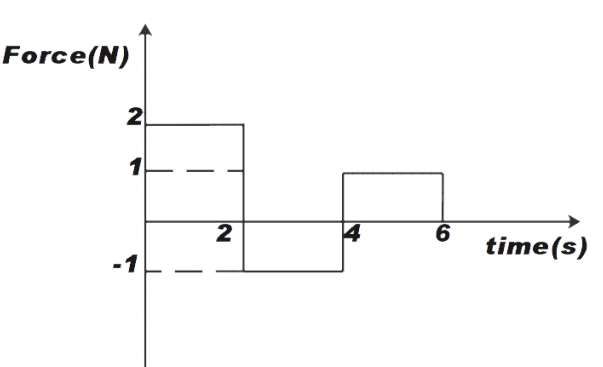
A Force time graph for a linear momentum is shown in figure. The linear momentum gained between 0 and 6 seconds is:

A. 2 Ns
B. 4 Ns
C. 6 Ns
D. zero

Answer
488.4k+ views
1 likes
Hint: This question asks us to calculate the linear momentum from the given figure. To calculate the linear momentum, we will be finding the area under the curve of the given Force –Time graph, since the area under the curve of force-time gives the momentum.
Complete step-by-step answer:
We know that the values above the X- axis are taken as positive and below it, are taken as negative. From the given figure, we can say that, in the first two seconds the force applied is +2 N, the force applied in the next two seconds i.e. 2 - 4 seconds is -1 N and the last two seconds i.e. 4-6 seconds the force applied is +1 N.
We know the momentum is given by the area under the force time curve. The area in every two second interval seems like a rectangle.
Therefore, area for first two seconds is
Similarly, area for next two seconds is
The area for last two seconds is
Now, the total area under the curve will be given by addition of (1), (2) and (3)
Therefore,
A =
A = 4 + (-2) + 2
Therefore,
A = 4 Ns
So, the correct answer is “Option B”.
Note: We know that in a force time graph, force is given on Y- axis and time is given X- axis. In a force time graph the slope does not matter. But, the area under force-time is very important. The area under force-time is force multiplied by time, which gives us the quantity called impulse. We know that impulse is a change in momentum of the object. So, we can calculate momentum from a force-time graph.
Complete step-by-step answer:
We know that the values above the X- axis are taken as positive and below it, are taken as negative. From the given figure, we can say that, in the first two seconds the force applied is +2 N, the force applied in the next two seconds i.e. 2 - 4 seconds is -1 N and the last two seconds i.e. 4-6 seconds the force applied is +1 N.
We know the momentum is given by the area under the force time curve. The area in every two second interval seems like a rectangle.
Therefore, area for first two seconds is
Similarly, area for next two seconds is
The area for last two seconds is
Now, the total area under the curve will be given by addition of (1), (2) and (3)
Therefore,
A =
A = 4 + (-2) + 2
Therefore,
A = 4 Ns
So, the correct answer is “Option B”.
Note: We know that in a force time graph, force is given on Y- axis and time is given X- axis. In a force time graph the slope does not matter. But, the area under force-time is very important. The area under force-time is force multiplied by time, which gives us the quantity called impulse. We know that impulse is a change in momentum of the object. So, we can calculate momentum from a force-time graph.
Latest Vedantu courses for you
Grade 8 | CBSE | SCHOOL | English
Vedantu 8 CBSE Pro Course - (2025-26)
School Full course for CBSE students
₹45,300 per year
Recently Updated Pages
Master Class 9 General Knowledge: Engaging Questions & Answers for Success

Master Class 9 English: Engaging Questions & Answers for Success

Master Class 9 Science: Engaging Questions & Answers for Success

Master Class 9 Social Science: Engaging Questions & Answers for Success

Master Class 9 Maths: Engaging Questions & Answers for Success

Class 9 Question and Answer - Your Ultimate Solutions Guide

Trending doubts
State and prove Bernoullis theorem class 11 physics CBSE

What are Quantum numbers Explain the quantum number class 11 chemistry CBSE

Who built the Grand Trunk Road AChandragupta Maurya class 11 social science CBSE

1 ton equals to A 100 kg B 1000 kg C 10 kg D 10000 class 11 physics CBSE

State the laws of reflection of light

One Metric ton is equal to kg A 10000 B 1000 C 100 class 11 physics CBSE




